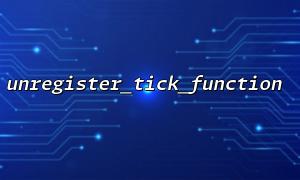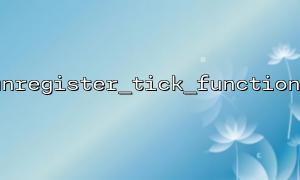In PHP, the tick function is a special mechanism that allows you to call a predefined function on each tick event point during PHP code execution. Usually used in conjunction with declare(ticks=1) syntax. After registering the tick processing function using register_tick_function , we sometimes need to cancel the registration of the tick function in a specific scenario. At this time, we need to use unregister_tick_function .
This article will introduce in detail the usage of unregister_tick_function , applicable scenarios, and how to correctly stop the registered tick function. We will also give you complete code examples to help you understand how it works.
The tick mechanism allows you to perform certain operations on each tick point when the PHP script is executed. This is very useful in debugging, performance monitoring, resource release and other scenarios. The definition of the tick point comes from declare(ticks=N) , where N is the frequency that triggers the tick function.
Register a tick function using register_tick_function , for example:
<code> declare(ticks=1); function my_tick_handler() {
echo "Tick at: " . microtime(true) . "\n";
}
register_tick_function('my_tick_handler');
</code>
The above code calls the my_tick_handler function at each tick point.
Use unregister_tick_function to stop a registered tick function. It is very straightforward to use, just pass in the function name or callback you want to unregister:
<code> unregister_tick_function('my_tick_handler'); </code>Once the above code is executed, the subsequent tick event will no longer trigger my_tick_handler .
Here is a complete example showing how to register and log out of the tick function during runtime:
<code> <?php declare(ticks=1); function my_tick_handler() {
echo "Tick handler triggered at: " . microtime(true) . "\n";
}
// Register the tick function
register_tick_function('my_tick_handler');
// Execute some code, the tick function will trigger
for ($i = 0; $i < 3; $i++) {
echo "Loop iteration: $i\n";
usleep(100000);
}
// Log out the tick function
unregister_tick_function('my_tick_handler');
echo "Tick function unregistered.\n";
// Execute the code again, the tick function will not trigger again at this time
for ($i = 3; $i < 6; $i++) {
echo "Loop iteration: $i\n";
usleep(100000);
}
</code>
An output example might be as follows:
Tick handler triggered at: 1716621733.1234
Loop iteration: 0
Tick handler triggered at: 1716621733.2235
Loop iteration: 1
Tick handler triggered at: 1716621733.3236
Loop iteration: 2
Tick function unregistered.
Loop iteration: 3
Loop iteration: 4
Loop iteration: 5
If you are registering a class method instead of a global function, you can register using the following method:
<code> class Monitor { public static function tick() { echo "Class tick\n"; } } register_tick_function(['Monitor', 'tick']);
// ... some code
unregister_tick_function(['Monitor', 'tick']);
</code>
Note that the callbacks used during registration and cancellation must be consistent.
Debugging the execution process : The tick function can help you understand the detailed timing of the program execution process.
Resource Release : Automatically release some temporary resources under specific conditions.
Performance monitoring : Used in conjunction with the log system to record the tick time for performance analysis.
Anomaly detection during development : Tick monitoring of key code segments to capture potential problems.
The smaller the value of declare(ticks=N) , the higher the frequency of calling the tick function, and the greater the impact on performance.
Multiple tick functions can be registered, but be careful not to do too many time-consuming operations in the tick function.
The unregister_tick_function must be passed in the exact same callback definition as when registering, otherwise the unregistration cannot be successfully cancelled.
unregister_tick_function is an important tool in PHP to stop tick function calls. By combining register_tick_function and declare(ticks=1) , you can flexibly control your own logic in the execution of the program, and you can gracefully exit this control when it is no longer needed. Mastering it can make your PHP programs more powerful and flexible in debugging and monitoring.
If you are developing a small framework or debugging tool that requires event awareness or periodic processing, such as if you integrate performance probes in a gitbox.net project, the tick mechanism is undoubtedly one option you can consider.




